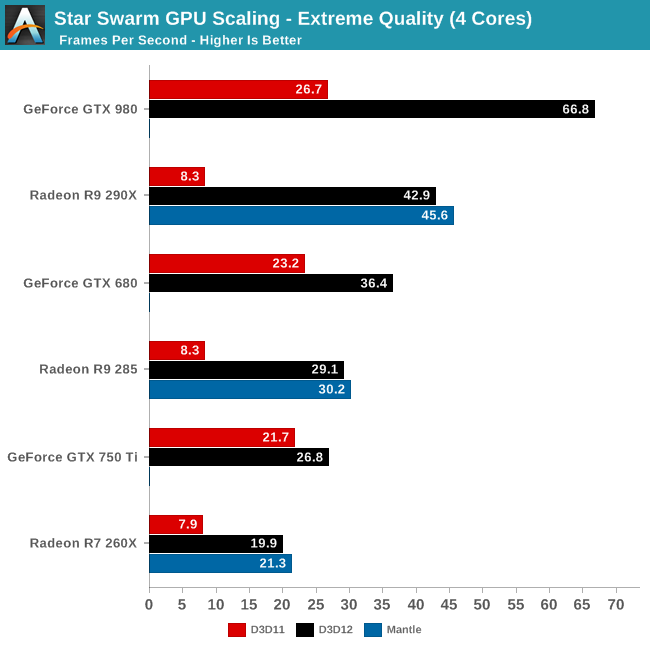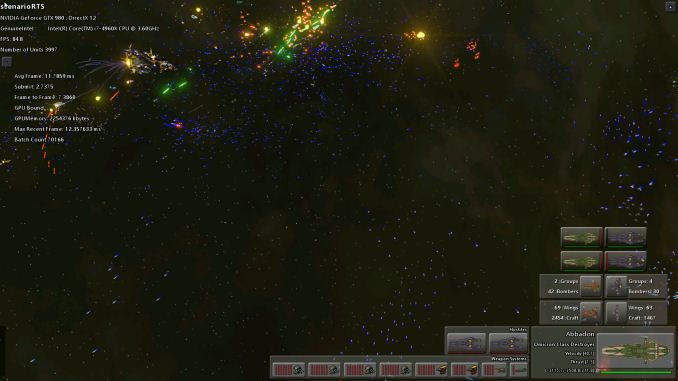The DirectX 12 Performance Preview: AMD, NVIDIA, & Star Swarm
by Ryan Smith on February 6, 2015 2:00 PM EST- Posted in
- GPUs
- AMD
- Microsoft
- NVIDIA
- DirectX 12
Star Swarm & The Test
For today’s DirectX 12 preview, Microsoft and Oxide Games have supplied us with a newer version of Oxide’s Star Swarm demo. Originally released in early 2014 as a demonstration of Oxide’s Nitrous engine and the capabilities of Mantle, Star Swarm is a massive space combat demo that is designed to push the limits of high-level APIs and demonstrate the performance advantages of low-level APIs. Due to its use of thousands of units and other effects that generate a high number of draw calls, Star Swarm can push over 100K draw calls, a massive workload that causes high-level APIs to simply crumple.
Because Star Swarm generates so many draw calls, it is essentially a best-case scenario test for low-level APIs, exploiting the fact that high-level APIs can’t effectively spread out the draw call workload over several CPU threads. As a result the performance gains from DirectX 12 in Star Swarm are going to be much greater than most (if not all) video games, but none the less it’s an effective tool to demonstrate the performance capabilities of DirectX 12 and to showcase how it is capable of better distributing work over multiple CPU threads.
It should be noted that while Star Swarm itself is a synthetic benchmark, the underlying Nitrous engine is relevant and is being used in multiple upcoming games. Stardock is using the Nitrous engine for their forthcoming Star Control game, and Oxide is using the engine for their own game, set to be announced at GDC 2015. So although Star Swarm is still a best case scenario, many of its lessons will be applicable to these future games.
As for the benchmark itself, we should also note that Star Swarm is a non-deterministic simulation. The benchmark is based on having two AI fleets fight each other, and as a result the outcome can differ from run to run. The good news is that although it’s not a deterministic benchmark, the benchmark’s RTS mode is reliable enough to keep the run-to-run variation low enough to produce reasonably consistent results. Among individual runs we’ll still see some fluctuations, while the benchmark will reliably demonstrate larger performance trends.
The Test
For today’s preview Microsoft, NVIDIA, and AMD have provided us with the necessary WDDM 2.0 drivers to enable DirectX 12 under Windows 10. The NVIDIA driver is 349.56 and the AMD driver is 15.200. At this time we do not know when these early WDDM 2.0 drivers will be released to the public, though we would be surprised not to see them released by the time of GDC in early March.
In terms of bugs and other known issues, Microsoft has informed us that there are some known memory and performance regressions in the current WDDM 2.0 path that have since been fixed in interim builds of Windows. In particular the WDDM 2.0 path may see slightly lower performance than the WDDM 1.3 path for older drivers, and there is an issue with memory exhaustion. For this reason Microsoft has suggested that a 3GB card is required to use the Star Swarm DirectX 12 binary, although in our tests we have been able to run it on 2GB cards seemingly without issue. Meanwhile DirectX 11 deferred context support is currently broken in the combination of Star Swarm and NVIDIA's drivers, causing Star Swarm to immediately crash, so these results are with D3D 11 deferred contexts disabled.
For today’s article we are looking at a small range of cards from both AMD and NVIDIA to showcase both performance and compatibility. For NVIDIA we are looking at the GTX 980 (Maxwell 2), GTX 750 Ti (Maxwell 1), and GTX 680 (Kepler). For AMD we are looking at the R9 290X (GCN 1.1), R9 285 (GCN 1.2), and R9 260X (GCN 1.1). As we mentioned earlier support for Fermi and GCN 1.0 cards will be forthcoming in future drivers.
Meanwhile on the CPU front, to showcase the performance scaling of Direct3D we are running the bulk of our tests on our GPU testbed with 3 different settings to roughly emulate high-end Core i7 (6 cores), i5 (4 cores), and i3 (2 cores) processors. Unfortunately we cannot control for our 4960X’s L3 cache size, however that should not be a significant factor in these benchmarks.
| DirectX 12 Preview CPU Configurations (i7-4960X) | |||
| Configuration | Emulating | ||
| 6C/12T @ 4.2GHz | Overclocked Core i7 | ||
| 4C/4T @ 3.8GHz | Core i5-4670K | ||
| 2C/4T @ 3.8GHz | Core i3-4370 | ||
Though not included in this preview, AMD’s recent APUs should slot between the 2 and 4 core options thanks to the design of AMD’s CPU modules.
| CPU: | Intel Core i7-4960X @ 4.2GHz |
| Motherboard: | ASRock Fatal1ty X79 Professional |
| Power Supply: | Corsair AX1200i |
| Hard Disk: | Samsung SSD 840 EVO (750GB) |
| Memory: | G.Skill RipjawZ DDR3-1866 4 x 8GB (9-10-9-26) |
| Case: | NZXT Phantom 630 Windowed Edition |
| Monitor: | Asus PQ321 |
| Video Cards: | AMD Radeon R9 290X AMD Radeon R9 285 AMD Radeon R7 260X NVIDIA GeForce GTX 980 NVIDIA GeForce GTX 750 Ti NVIDIA GeForce GTX 680 |
| Video Drivers: | NVIDIA Release 349.56 Beta AMD Catalyst 15.200 Beta |
| OS: | Windows 10 Technical Preview 2 (Build 9926) |
Finally, while we’re going to take a systematic look at DirectX 12 from both a CPU standpoint and a GPU standpoint, we may as well answer the first question on everyone’s mind: does DirectX 12 work as advertised? The short answer: a resounding yes.












245 Comments
View All Comments
Archetype - Saturday, August 1, 2015 - link
They did not optimize the hell out of it for NVidia. They just added DX12 support. Originally it was just for DX11 on any card and Mantle supported by AMD. It is not a game - Its a tech demo.The 980 obviously has significant horse power. I am just unsure why they used a 290x and not the current flagship. But maybe the 290x is still supposed to be more powerful.
Freosan - Sunday, August 2, 2015 - link
Archetype. When this was published, the 290x WAS the current AMD flagship.Azix - Monday, August 3, 2015 - link
flagship was 295x2Archetype - Saturday, August 1, 2015 - link
They explained it quite clearly. Starswarm was written specifically to have zounds of draw calls and as such a high level API (layers and layers of API between the code that draws the scenes) will not be able to deal with it well. That was the whole point of Mantle and now DX12. To remove some of those layers of API and give software more direct access to underlying drivers and through them the hardware. You really need to get more informed.Flunk - Friday, February 6, 2015 - link
That might annoy me more if they weren't giving everyone on Windows 7 and 8 an upgrade to 10 for nothing. I suppose not having to backport this to Windows 8 (as was originally announced) is probably saving a fair amount.dakishimesan - Friday, February 6, 2015 - link
Sorry for my laziness, I was actually just pointing out a spelling mistake; I think it should say because DirectX 12… Etc.But for what it's worth I agree with you, with windows 10 being a free upgrade, and only enthusiast really caring about direct X 12 on their current high performance gear, I have no problem with Microsoft doing it this way.
Christopher1 - Monday, February 16, 2015 - link
Exactly. I understood why people were reticent to upgrade to Windows 7 and 8 because it was a paid upgrade, but with Windows 10 being a free upgrade if you have Windows 7 or 8? No reason not to upgrade.yuhong - Friday, February 6, 2015 - link
Yea, the old DirectX redists are long dead.Wwhat - Saturday, February 7, 2015 - link
I'm highly suspicious about windows 10.There is a reason why they give it for free, as the saying goes "If You're Not Paying for It; You're the Product", which is generally true these days if it comes from a commercial outfit.
damianrobertjones - Saturday, February 7, 2015 - link
The more that people use the Windows store the more profit MS makes. Simple.